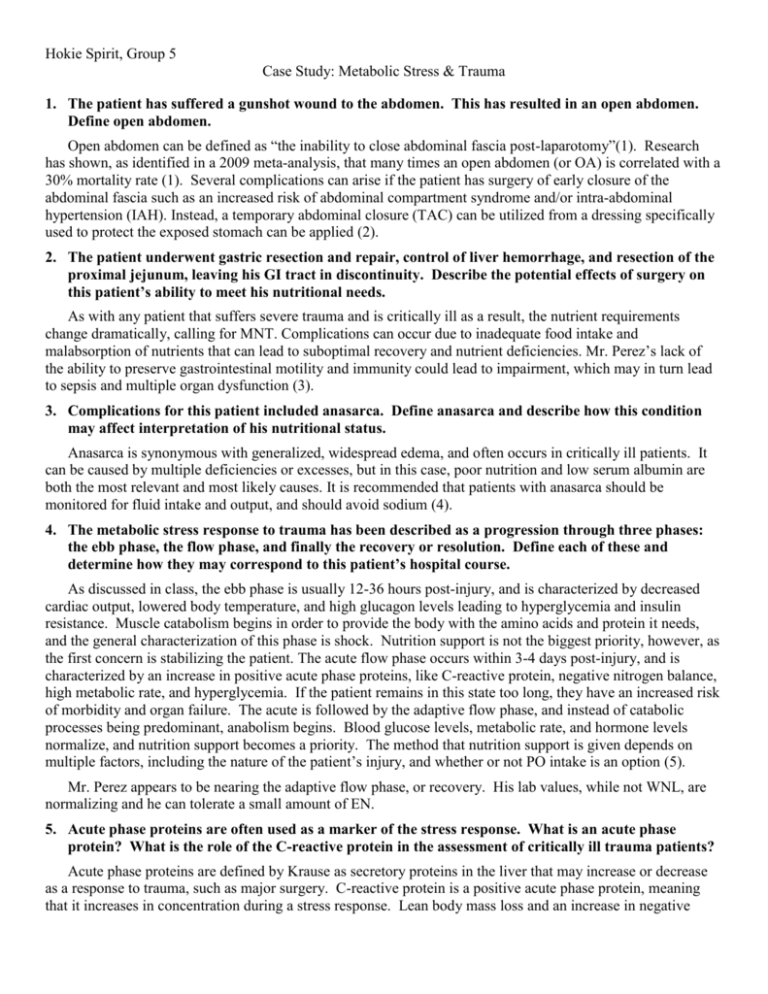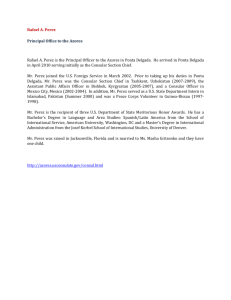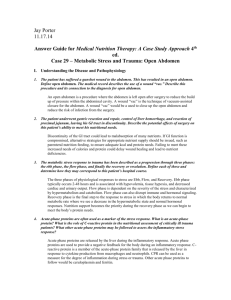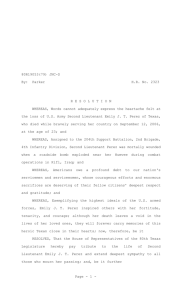Hokie Spirit, Group 5 Case Study: Metabolic Stress & Trauma 1. The
advertisement

Hokie Spirit, Group 5 Case Study: Metabolic Stress & Trauma 1. The patient has suffered a gunshot wound to the abdomen. This has resulted in an open abdomen. Define open abdomen. Open abdomen can be defined as “the inability to close abdominal fascia post-laparotomy”(1). Research has shown, as identified in a 2009 meta-analysis, that many times an open abdomen (or OA) is correlated with a 30% mortality rate (1). Several complications can arise if the patient has surgery of early closure of the abdominal fascia such as an increased risk of abdominal compartment syndrome and/or intra-abdominal hypertension (IAH). Instead, a temporary abdominal closure (TAC) can be utilized from a dressing specifically used to protect the exposed stomach can be applied (2). 2. The patient underwent gastric resection and repair, control of liver hemorrhage, and resection of the proximal jejunum, leaving his GI tract in discontinuity. Describe the potential effects of surgery on this patient’s ability to meet his nutritional needs. As with any patient that suffers severe trauma and is critically ill as a result, the nutrient requirements change dramatically, calling for MNT. Complications can occur due to inadequate food intake and malabsorption of nutrients that can lead to suboptimal recovery and nutrient deficiencies. Mr. Perez’s lack of the ability to preserve gastrointestinal motility and immunity could lead to impairment, which may in turn lead to sepsis and multiple organ dysfunction (3). 3. Complications for this patient included anasarca. Define anasarca and describe how this condition may affect interpretation of his nutritional status. Anasarca is synonymous with generalized, widespread edema, and often occurs in critically ill patients. It can be caused by multiple deficiencies or excesses, but in this case, poor nutrition and low serum albumin are both the most relevant and most likely causes. It is recommended that patients with anasarca should be monitored for fluid intake and output, and should avoid sodium (4). 4. The metabolic stress response to trauma has been described as a progression through three phases: the ebb phase, the flow phase, and finally the recovery or resolution. Define each of these and determine how they may correspond to this patient’s hospital course. As discussed in class, the ebb phase is usually 12-36 hours post-injury, and is characterized by decreased cardiac output, lowered body temperature, and high glucagon levels leading to hyperglycemia and insulin resistance. Muscle catabolism begins in order to provide the body with the amino acids and protein it needs, and the general characterization of this phase is shock. Nutrition support is not the biggest priority, however, as the first concern is stabilizing the patient. The acute flow phase occurs within 3-4 days post-injury, and is characterized by an increase in positive acute phase proteins, like C-reactive protein, negative nitrogen balance, high metabolic rate, and hyperglycemia. If the patient remains in this state too long, they have an increased risk of morbidity and organ failure. The acute is followed by the adaptive flow phase, and instead of catabolic processes being predominant, anabolism begins. Blood glucose levels, metabolic rate, and hormone levels normalize, and nutrition support becomes a priority. The method that nutrition support is given depends on multiple factors, including the nature of the patient’s injury, and whether or not PO intake is an option (5). Mr. Perez appears to be nearing the adaptive flow phase, or recovery. His lab values, while not WNL, are normalizing and he can tolerate a small amount of EN. 5. Acute phase proteins are often used as a marker of the stress response. What is an acute phase protein? What is the role of the C-reactive protein in the assessment of critically ill trauma patients? Acute phase proteins are defined by Krause as secretory proteins in the liver that may increase or decrease as a response to trauma, such as major surgery. C-reactive protein is a positive acute phase protein, meaning that it increases in concentration during a stress response. Lean body mass loss and an increase in negative Hokie Spirit, Group 5 2 nitrogen balance are often noted in a critically ill trauma patient, which would require a dramatic increase in the patient’s protein requirements and supplementation (3). 6. Metabolic stress and trauma significantly affect nutritional requirements. Describe the changes in nutrient metabolism that occur in metabolic stress. Specifically address energy requirements and changes in carbohydrate, protein, and lipid metabolism. In a critically ill trauma patient, respiratory quotient increases, which increases nutrient requirements overall. With an increase in resting energy expenditure, there are heavy demands on the body and increased nutrient needs. The main goal in any route of nutrition therapy chosen is to prevent catabolism. While energy needs are increased, overfeeding is a risk in obese populations, and research has shown that providing 22 kcal/kg of ideal body weight was correlated with positive outcomes in this population. Glycolysis, a catabolic process, occurs until the body’s glycogen stores are used up, which often happens in approximately 24 hours. Protein catabolism increases to produce glucose for the body to use as fuel, leading to muscle atrophy and decreased muscle mass. Levels of urinary nitrogen loss are elevated as well. Extremely high needs and losses require supplementation in order to slow or cease muscle degradation and overall catabolism, often administered at levels of 2g/kg/d. Eventually, lipid stores are used for fuel as well, except in the systems that rely on glucose like the brain, red blood cells, and the nervous system (3). 7. Are there specific requirements that should be considered when designing nutrition support for a trauma patient? Explain the rationale and current recommendations regarding glutamine, arginine, and omega-3 fatty acids for this patient population. Using formulas containing glutamine, arginine, and omega-3 fatty acids are correlated with positive patient outcomes in trauma cases due to these compounds’ immune-enhancing effects. Often times, the hospital stay and rate of infection is reduced in this population when given this type of formula. Omega-3 fatty acid supplementation can help reduce inflammation. Glutamine is an important fuel for enterocytes in metabolic stress and trauma. It has been shown to reduce gut permeability as well as the inflammatory response the gut produces in trauma. One concern, however, is that glutamine is instable in solution which has led to its decreased use in TPN formulation (3). For critically ill patients, requirements are higher because catabolism causes the loss of lean muscle tissue. The addition of the amino acids can help decrease the negative nitrogen balance by supplying the liver with substrates for protein synthesis which reduces the need of endogenous proteins from other tissues (3). 8. Explain the decision-making process that would be applied in determining the route for nutrition support for the trauma patient. For any person, sick or healthy, oral nutrition is the natural referred choice- the body is designed for food ingested by mouth to be digested in the stomach and absorbed in the intestines. Unfortunately, in critically ill trauma patients oral nutrition support is often impossible due to high-energy demands and impaired GI tract function. If it is clear that oral nutrition is not possible, then enteral nutrition (EN) and parenteral nutrition (TPN) are secondary options. ASPEN has developed a chart, which is listed in the Krause text, which outlines the needs and requirements of both EN and TPN. If the GI tract is functional (at least partially), there is no intestinal hemorrhage, no ileus present, no evidence of pancreatitis, no vomiting, or diarrhea, no fistulas, and a regular-length bowel, EN is clearly the best choice (3). At any point, if any of the items listed prior are present, then there is a contraindication for EN and TPN should be considered to meet some, if not all, of the patient’s nutrient needs. The most important consideration to be made is that ever case is unique, and a course of treatment needs to be patient-specific. In the case of Juan, the patient in question, both oral and enteral nutrition are not feasible due to his discontinuous GI tract. TPN was the clear choice here in order to meet his nutrient needs. Positive outcomes are associated with small amounts of EN being administered in conjunction with TPN to maintain the gut’s integrity and intestinal mucosa, but there is a potential for intestinal ischemia and necrosis if EN is administered Hokie Spirit, Group 5 3 too soon (3). The patient needs to be stable and recovering from the trauma before an attempt is made, and at day 11, Mr. Perez is receiving EN. 9. What factors make assessing his weight difficult on a daily basis? Because of Mr. Perez’s anasarca, he is retaining an excess amount of fluid, and that alone affects his weight. How much of his measured body weight is a result of water retention, and how that changes with his fluid intake is unknown, making it difficult to monitor daily changes. In addition, mechanical ventilation makes it impossible for Mr. Perez to be mobile, which does not allow him to move from his bed to be weighed or for a bed scale to be zeroed. 10. Calculate energy and protein requirements for Mr. Perez. Use 2 predictive equations and explain your rationale. Pre-admission: Ht: 70” Wt: 225# (~102kg) IBW: 166#, %IBW: 135% OBESE BMI: 102kg/(1.78m2) = 32.2 OBESITY CLASS I 1. IJEE: for ventilator-dependent male pt c trauma (UBW used due to edema and wt fluctuations) 1784-(11*29)+(5*102kg)+244+239 = 2458 kcal/d 2. Krause book: 22kcal/d recommended for mechanically ventilated critically ill obese pt (UBW used due to edema and wt fluctuations) 22kcal/d*102kg = 2244 kcal/d 11. What does indirect calorimetry measure? Indirect calorimetry is used to determine the amount of calories an individual burns over a certain period of time. It can be used to find an individual’s resting metabolic rate as well as the amount of calories burned when active (3). The estimated energy expenditure is determined through the measurement of the amount of oxygen consumed and the amount of carbon dioxide expelled. This is generally done through the use of a mouth piece or ventilated hood, both of which gather a patient’s expired gases. In a clinical environment, indirect calorimetry can also be done through the use of metabolic carts (3). 12. What are the indications for obtaining a metabolic cart (indirect calorimetry) for this patient? A metabolic cart is a tool used to determine an individual’s metabolism through the measurement of the amount of heat the body produces when at rest (6). It is generally used in an emergency room or ICU setting to gather more information from a patient who may not be able to adequately describe his/her current condition (6). As stated in the study, upon arrival, Mr. Perez was not at nutritional risk. However, he is currently at high risk due to the need for mechanical ventilation, a large gunshot wound, loss of fluids and electrolytes, altered GI function, and the need for TPN (5). Since Mr. Perez is under severe stress and experiencing a great deal of pain, he may be unable to effectively respond to questions asked by the medical staff. Along with the inadequate information provided by Mr. Perez, there were also many factors affected by the GSW and the metabolic cart would provide the staff with a better idea of his current energy needs. Some of the underlying complications resulting from the GSW were unable to be seen and taken into account when using general equations to calculate his energy needs. The use of a medical cart would help the medical staff observe the body’s metabolism and get a better understanding of the patient’s immediate conditions (6). Some factors affecting Mr. Perez’s energy requirement include the surgeries that he underwent, the fact that he is on mechanical ventilation, blood loss and the presence of 4+ bilateral pedal edema. These Hokie Spirit, Group 5 4 factors could lead to a decline in Mr. Perez’s health status and could also lead to the development of other nutrition related problems. In order to avoid the incorrect administration of energy to Mr. Perez, the healthcare team decided to use the metabolic cart to ensure that the patient’s energy needs were accurately met. 13. Compare the estimated energy needs calculated using the predictive equations with each other and with those obtained by indirect calorimetry measurements. On day 4, the metabolic cart revealed that Mr. Perez’s energy expenditure was 3657 kcals/d and on day 10, the metabolic cart measured his energy expenditure at 3765 kcals/d. However, when using the Ireton-Jones and Krause book equations, Mr. Perez’s energy requirement was estimated at a much lower level than what was measured using the metabolic cart. When using the Ireton-Jones equation, the energy requirement for Mr. Perez was estimated at 2458 kcal/d and when using the Krause book equation, his energy requirement was estimated at 2244 kcals/d. When comparing the measurements from the metabolic cart to the predictive equations used to calculate his estimated energy needs, the Ireton-Jones Energy equation was the closest to his actual energy expenditure (when using Mr. Perez’s usual body weight and a trauma factor). This wide variation between energy requirements emphasizes the importance of accuracy and precision within a medical environment. The 1307 kcal difference between the measurements gathered from indirect calorimetry and the predictive equations is evidence that in certain situations, such as Mr. Perez’s, indirect calorimetry provides a more accurate measurement than the predictive equations. In circumstances like Mr. Perez’s, it is extremely challenging to accurately factor in everything that the body is undergoing. As a result, relying on predictive equations to determine a patient’s needs could lead to inaccurate caloric administration and instead, indirect calorimetry should be used in order to accurately determine the energy requirement. 14. Interpret the RQ values. What do they indicate? Respiratory Quotient (RQ) = Moles CO₂ expired / Moles O₂ consumed An RQ value of 0.70 means that fat is being used as the primary energy source and an RQ value of 0.82 means that protein is being used as the main energy source (3). When TPN was originally administered (day 4), Mr. Perez had an RQ value of 0.76 which indicated that the majority of his energy came from oxidized fats. On day 10, his RQ value dropped to 0.70 indicating that solely fats were being oxidized as the energy source. These RQ values may be a result from the administration of propofol @ 35 ml/hr, which contains the equivalent of a 10% lipid solution. 15. What factors contribute to the elevated energy expenditure in this patient? There are many factors contributing to Mr. Perez’s need for an increase in energy intake and are as follows: Trauma and stress resulting from the GSW. Corrective surgeries that he underwent (upon arrival: exploratory damage-control laparotomy, gastric repair, control of liver hemorrhage, and resection of proximal jejunum, which left his GI tract in discontinuity). Mechanical ventilation. An anastomotic leak. Fluid and electrolyte losses. Parenteral nutrition support. Hokie Spirit, Group 5 5 16. Mr. Perez was prescribed parenteral nutrition and was to receive 300 g of dextrose and 170 g of amino acids per day. Determine how many kcals and grams of protein are provided with this prescription. Read the patient care summary sheet. What was the total volume of PN provided that day? 300g dextrose x 3.4 kcals/g = 1020 kcals CHO 170 g pro x 4 kcals/g = 680 kcals protein 170 g pro / 102.27 kg = 1.66 or 1.7 g/pro/kg Total kcals = 1020 + 680 = 1700 kcal/d Total TPN volume: 75ml/hr x 24hrs = 1800ml With this prescription, 680 kcals/d come from protein and 1020 kcals/d come from carbohydrates to make a total of 1700 kcals/d that were provided to the patient. In addition, 170 g of protein were also being supplied. The total volume of TPN given to Mr. Perez, as reported in the patient care summary, is 75 ml/hr (1800 ml/d). 17. Compare this nutrition support to his measured energy requirements obtained by the metabolic cart on day 4. Based on the metabolic cart results, what changes would you recommend be made to the TPN regimen, if any? What are the limitations that prevent the health care team from making significant changes to the nutrition support regimen? On day 4, the metabolic cart reported Mr. Perez’s kcal expenditure at 3657 kcals/d, with an RQ value of 0.76. When comparing the nutrition support from the TPN, initiated on day 2, to the results of the metabolic cart, the energy provided by TPN was suboptimal compared to the requirement reported by the calorimeter. If Mr. Perez is only receiving 1700 kcals/d, he is at a calorie deficit of 1957 kcals/d. Based on the metabolic cart results, it may be beneficial to increase his energy intake through an increase in his protein requirement. When calculated, 1.7 g/pro/kg are being provided, however this could be increased up to 2.5 g/pro/kg in order to provide Mr. Perez with a higher energy intake. Not only would an increase in protein provide the patient with more energy, but an increase in protein requirement would also be beneficial in wound healing. Other than that, drastically changing the TPN regimen could be detrimental. With his stress and GI complications, it is important not to overfeed and to provide him with nutrition support at a level he can tolerate. There are several limitations that prevent the healthcare team from making any significant changes to the nutrition support regimen. These include: mechanical ventilation, anasarca, GI tract discontinuity, a liver hemorrhage and anastomotic leak. The anastomotic leak is certainly a limitation since it caused a reduction in the volume of enteral feeding administered to the patient. As a result, the volume of formula needs to be monitored in order to reduce the pressure and risk of leakage. 18. The patient was also receiving propofol. What is this, and why should it be included in an assessment of his nutritional intake? How much energy did it provide? Propofol is a sedative that helps “reduce anxiety and tension [while promoting] relaxation and sleep…” (7). It is generally used during short diagnostic tests and surgical consciousness (7). It should be included in the assessment because it has a fat content similar to a 10% lipid solution which provides 1.1kcals/ml (5). It was administered at a rate of 35 ml/hr, so in a 24hr period it provided around 924 kcals/d of lipid (35 ml/hr x 1.1 kcals/ml x 24 hrs = 924 kcals/d). This can significantly affect the amount of kcals that are being administered in a day. If propofol levels are high, it can provide a significant amount of kcals and should be taken into account when evaluating Mr. Perez’s energy requirements. If the calories coming from propofol are overlooked, he could end up taking in more energy than required. Hokie Spirit, Group 5 6 19. On day 11, the patient started on an enteral feeding. If his nutrient needs were met by parenteral nutrition, why was enteral feeding started? The reports from the metabolic carts showed that Mr. Perez was expending over 3000 kcals/d. Even when factoring in the energy provided from propofol, he was still only receiving 2624 kcals which did not meet his energy needs. Mr. Perez also has an inability to take in adequate nutrition PO resulting from the laparotomy, gastric repair and resection of the proximal jejunum. He is also under severe stress and trauma from the GSW and multiple surgeries, both of which negatively affected the function of the GI tract. These are all indications for enteral nutrition (EN) and support the initiation of EN support for Mr. Perez. The EN was initiated on day 12, so the patient was more stable than he was when he was first admitted. When first admitted, Mr. Perez was vomiting blood, had an unattended GSW and had other GI complications which prevented the initiation of EN support since those were all contraindications for enteral feeding. As a result, TPN was the only option. Once the patient was stable, EN was able to be initiated. EN is a less expensive option that enhances immune competence, prevents intestinal atrophy, protects against translocation of bacteria and has a decreased risk of complications and infections when compared to TPN. Having both TPN and EN nutritional support would help provide Mr. Perez with the high energy requirements that he needs to recover. 20. This patient received the formula Crucial. What type of enteral formula is this? Why was this type of formula used? How many kilocalories are being provided by enteral nutrition support and what percent of his total nutritional intake does this represent? Crucial is a formula designed for immune support and “is formulated to meet the complex nutritional needs of patients suffering from trauma, major surgery, hypermetabolism, burns, malabsorption, head injury and chronic pressure ulcers” (8). It is also a lactose and gluten free formula that is used to, “promote absorption and tolerance in critically ill patients with GI-dysfunction.” (9). This formula was used to supply Mr. Perez with high calorie, high protein nutrition to support the healing of his body and help with the dietary management of trauma, wound management, pre/post surgery, limited gut function, ventilator dependency and other factors that are responsible for his increased energy and protein needs. Crucial can also be used along with TPN, which is what is happening with this particular patient (8). On day 13, EN was advanced to 20 ml/hr, but was later reduced to 15 ml/hr due to drainage from an anastomotic leak. Crucial provides 1.5 kcals/ml, so in a 20-22 hour period EN was providing 450-495 kcals/d. (15 ml/hr x 1.5 kcals/ml x 20 hrs = 450 kcals/d) (15 ml/hr x 1.5kcals/ml x 22 hrs = 495 kcals/d) This means that with TPN and EN combined, Mr. Perez was receiving between 3074-3119 kcals/d. Using the high end of the kcal range: % of kcals provided from EN = 495/ 3119 x 100 = 15.8 or 16% Of course, it is important to note that this depends on the cycle that the EN feeding was initiated on by the healthcare team. Towards the end of his stay, Mr. Perez was getting 15ml/hr of crucial which provided him with 22.5 kcals/hr, and if administered over a period of 22 hrs, the formula provided him with a total of 495 kcals/d. 21. From the information gathered within the intake domain, list possible nutrition problems using the appropriate diagnostic term. The following are possible nutrition problems that may affect Mr. Perez’s health status: Increased energy expenditure (NI – 1.2) Inadequate energy intake (NI – 1.4) Inadequate oral intake (NI – 2.1) Hokie Spirit, Group 5 7 Inadequate parenteral nutrition infusion (NI – 2. 6) (he is only being supplied with a small amount of his energy needs through PTN support) Less than optimal parenteral nutrition (NI – 2.5) Increased nutrient needs (protein) (NI – 5.1) 22. List abnormal biochemical values and describe why they might be abnormal. Normal Value Patient’s Value (Day 10) 3.5-5 g/dl 1.9 g/dl (L) 6-8 g/dl 5.1 g/dl (L) Osmolality 285-295 mmol/kg/H20 305 mmol/kg/H20 (H) Glucose 70-110 mg/dl 140 mg/dl (H) BUN 8-18 mg/dl 25 mg/dl (H) Parameter Albumin Total Protein C-Reactive Protein < 1.0 mg/dl 220 mg/dl (H) TG 40-160 mg/dl 265 mg/dl (H) Magnesium 1.8-3 mg/dl 1.5 mg/dl (L) Reason for abnormality Loss of blood (GSW) & dehydration Trauma, loss of blood, surgery & repair Loss of fluid control (GSW) Loss of blood (GSW), liver hemorrhage (lack of insulin) & stress Loss of fluids from GSW Liver Hemorrhage & GSW Metabolic syndrome and the use of propofol & IV lipids Loss of blood (GSW), GI alterations Nutrition Implication Low iron levels, malnutrition & edema (10) Edema and patient is at an increased need of protein (10) Edema (anasarca) Hyperglycemia (11) Dehydration (12) Presence of inflammation & possible infection (13) Obesity and poor lipid absorption (14) Hypomagnesemia (15) 23. Clinical Domain: Altered GI Function (NC – 1.4) Impaired nutrient utilization (NC -2.1) 24. PES statements 1) Altered GI function R/T GSW and abdominal surgery AEB TPN and EN initiation. (NC-1.4) 2) Less than optimal enteral nutrition R/T high nutritional needs and risk AEB anastomotic leakage and continued TPN. (NI-2.5) 25. Interventions and goals 1) Modify distribution and type of feeding: continue EN in conjunction with TPN and consider increased EN c increased pt tolerance. (ND-1.2) Hokie Spirit, Group 5 8 2) Site care: due to anastomotic leakage, consult with physician to repair leak and increase EN tolerance. (ND-2.1.3) Goals: Increase EN and pt tolerance Decrease TPN Reduce generalized edema Maintain protein balance Meet energy requirements 26. Nutrition Monitoring and Evaluation Continue to monitor weight, protein status, fluid volume in and out, abnormal lab values, any additional anastomotic leakage and EN tolerance. 27. Hyperglycemia was noted on the patient care monitoring sheet. List those values on day 4. Why is hyperglycemia of concern in the critically ill patient? How was this handled for this patient? The table below shows Mr. Perez’s blood glucose levels on day 4 of the patient care monitoring sheet. Hyperglycemia is a concern in the critically ill patient because a patient in this category is experiencing a great deal of stress and trauma. Stress can contribute to 20% of glucose production, and during stress the liver increases production of glucose by 200%. This can make the body become insulin resistant, which can lead to mortality. In order to monitor Mr. Perez’s glucose levels and to help reduce the risk for the development of hyperglycemia, he was put on an insulin drip protocol (3). Day 4: Blood Glucose Blood Hours Glucose 00 175 04 166 08 150 11 150 15 160 19 145 Hokie Spirit, Group 5 9 References 1. Boele van Hensbroek P, Wind J, Dijkgraaf M, Busch O, Carel Goslings J. Temporary Closure of the Open Abdomen: A Systematic Review on Delayed Primary Fascial Closure in Patients with an Open Abdomen. World Journal of Surgery 2009;33(2):199-207. doi: 10.1007/s00268-008-9867-3. 2. Open Abdomen. Available at: http://www.kci-medical.in/IN-ENG/openabdomen. Accessed October 25, 2011. 3. Mahan LK E-SS. Krause's Food and Nutrition Therapy. 12 ed. St. Louis, Missouri: Saunders Elsevier, 2008. 4. Vorvick L. Swelling - nutritional considerations. Medline Plus. October 28 ed: National Institute of Health, 2010. 5. Cochran B. Metabolic Stress and Trauma Lecture Notes. 2011. 6. WiseGeek: Clear Answers for Common Questions. What is a Metabolic Cart?; 2011, Conjecture Corporation. Available at: http: //www.wisegeek.com/what-is-a-metabolic-cart.htm. Accessed November 5, 2011. 7. Drug Information Online, Drugs.com. Propofol; 2011. Available at: http://www.drugs.com/ propofol.html. Accessed November 5, 2011. 8. AllegroMedical.com. Crucial-Complete Elemental Nutrition for Immune Support; 1997-2011, Allegro Medical Supplies Inc. Available at: http://www.allegromedical.com/dietary-supplements-c522/crucial250ml-8-oz-cans-unflavored-p548657.html. Accessed November 5, 2011. 9. Nestle-nutrition.com. Crucial - Complete Elemental Nutrition for Immune Support; August 2011, Nestle Nutrition. Available at: http://www.nestle-nutrition.com/products/Product. aspx?ProductId=a83692c6-23b44152-aa0d-f45cf0a5ffd9. Accessed November 5, 2011. 10. WikiAnswers, Answers.com. What Causes a Low Blood Protein Count?. Available at: http://wiki.answers.com/Q/What_causes_a_low_blood_protein_count. Accessed November 5, 2011. 11. Ferry, Robert Jr., MD. High Blood Sugar (Hyperglycemia); 2011, WebMD Inc. Available at: http://www.emedicinehealth.com/high_blood_sugar_hyperglycemia/article_em.htm. Accessed November 5, 2011. 12. WebMD, Better information. Better health. Blood Urea Nitrogen; August 9, 2010. Available at: http://www.webmd.com/a-to-z-guides/blood-urea-nitrogen. Accessed November 5, 2011. 13. MedlinePlus, Trusted Health Information for You. C-Reactive Protein; November 2, 2011. Available at: http://www.nlm.nih.gov/medlineplus/ency/article/003356.htm. Accessed November 5, 2011 14. WebMD, Better information. Better health. High Triglycerides- Overview; December 9, 2010. Available at: http://www.webmd.com/cholesterol-management/tc/high-triglycerides-overview. Accessed November 5, 2011. 15. Hamilton, Scott. Chemocare.com, Care During Chemotherapy and Beyond. Hypomagnesemia (Low Magnesium); 2005. Available at: http://www.chemocare.com/managing/ hypomagnesemia-lowmagnesium.asp. Accessed November 5, 2011.








